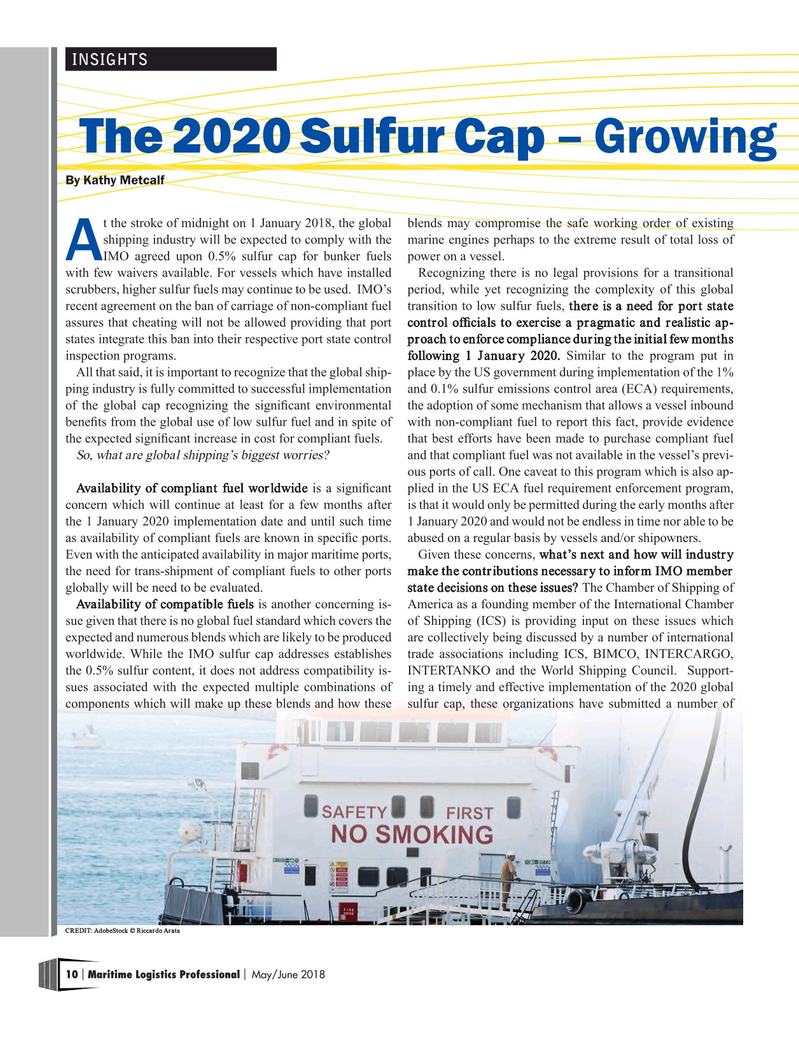
Page 10: of Maritime Logistics Professional Magazine (May/Jun 2018)
Container Ports
Read this page in Pdf, Flash or Html5 edition of May/Jun 2018 Maritime Logistics Professional Magazine
INSIGHTS
The 2020 Sulfur Cap – Growing
By Kathy Metcalf t the stroke of midnight on 1 January 2018, the global blends may compromise the safe working order of existing shipping industry will be expected to comply with the marine engines perhaps to the extreme result of total loss of
AIMO agreed upon 0.5% sulfur cap for bunker fuels power on a vessel.
with few waivers available. For vessels which have installed Recognizing there is no legal provisions for a transitional scrubbers, higher sulfur fuels may continue to be used. IMO’s period, while yet recognizing the complexity of this global recent agreement on the ban of carriage of non-compliant fuel transition to low sulfur fuels, there is a need for port state assures that cheating will not be allowed providing that port control offcials to exercise a pragmatic and realistic ap- states integrate this ban into their respective port state control proach to enforce compliance during the initial few months inspection programs. following 1 January 2020. Similar to the program put in
All that said, it is important to recognize that the global ship- place by the US government during implementation of the 1% ping industry is fully committed to successful implementation and 0.1% sulfur emissions control area (ECA) requirements, of the global cap recognizing the signifcant environmental the adoption of some mechanism that allows a vessel inbound benefts from the global use of low sulfur fuel and in spite of with non-compliant fuel to report this fact, provide evidence the expected signifcant increase in cost for compliant fuels. that best efforts have been made to purchase compliant fuel
So, what are global shipping’s biggest worries? and that compliant fuel was not available in the vessel’s previ- ous ports of call. One caveat to this program which is also ap-
Availability of compliant fuel worldwide is a signifcant plied in the US ECA fuel requirement enforcement program, concern which will continue at least for a few months after is that it would only be permitted during the early months after the 1 January 2020 implementation date and until such time 1 January 2020 and would not be endless in time nor able to be as availability of compliant fuels are known in specifc ports. abused on a regular basis by vessels and/or shipowners.
Even with the anticipated availability in major maritime ports, Given these concerns, what’s next and how will industry the need for trans-shipment of compliant fuels to other ports make the contributions necessary to inform IMO member globally will be need to be evaluated. state decisions on these issues? The Chamber of Shipping of
Availability of compatible fuels is another concerning is- America as a founding member of the International Chamber sue given that there is no global fuel standard which covers the of Shipping (ICS) is providing input on these issues which expected and numerous blends which are likely to be produced are collectively being discussed by a number of international worldwide. While the IMO sulfur cap addresses establishes trade associations including ICS, BIMCO, INTERCARGO, the 0.5% sulfur content, it does not address compatibility is- INTERTANKO and the World Shipping Council. Support- sues associated with the expected multiple combinations of ing a timely and effective implementation of the 2020 global components which will make up these blends and how these sulfur cap, these organizations have submitted a number of
CREDIT: AdobeStock © Riccardo Arata 10 Maritime Logistics Professional May/June 2018 | |

 9
9

 11
11
